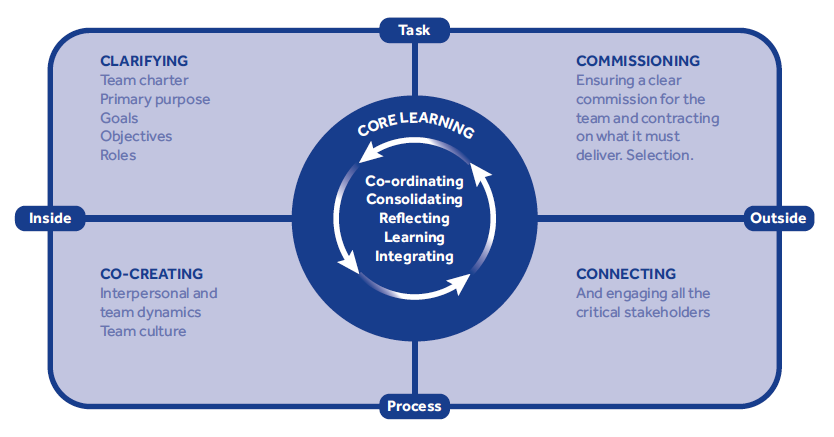Team coaching is currently the fastest growing form of coaching. Systemic team coaching is a dynamic model that brings together the best of coaching practice with the best of team and organisational development, to create a way of working with a whole team as a living system in relationship to its wider organisational and stakeholder eco-system.
We should recognise that, even if you only coach one-to-one, you will sooner or later find yourself indirectly working with teams, organisations and wider systems. This is because individual clients bring not just themselves to their coaching, but the dynamics of the teams they lead and work within, the organisational culture they are part of and the wider eco-systems they inhabit.
What makes a team?
The difference between a real team and a group of people who just report to the same boss, is that a team has a joint purpose that requires collaboration between the team members.
A team has a collective purpose and objective which its members are jointly responsible for fulfilling. This means that they are dependent on each other for the achievement of the objective and that ignoring this ‘interdependence’ will make them less effective. (Leary-Joyce & Lines, 2017)
That shared purpose is pivotal in creating the team, even more than the individuals involved or the relationships between them. For a team to be highly effective, it has to co-create value with and for all its stakeholders, both within the same organisation and externally (customers, suppliers, investors, partner organisations, the communities where it operates and the ‘more than human world’ of the ecological environment that sustains and supports us). Thus effective team coaching has to attend not only to the team’s internal relationships, but its purpose, performance and external relationships.
In today’s fast-changing world, team coaching must also enable teams to become effective learning teams that can constantly grow their collective capacity and agilely respond to the volatile environment. In light of this, Peter Hawkins first began developing the systemic team coaching model in 1990. This is a process:
…by which a team coach works with a whole team, both when they are together and when they are apart, in order to help them both improve their collective performance and how they work together, and also how they develop their collective leadership to more effectively engage with all their key stakeholder groups to jointly transform the wider business. (Hawkins, 2017)
In this definition, a significant differentiation is drawn between systemic team coaching and traditional team coaching (Level I) and also team coaching that focuses on the team as a bounded system (Level II), as shown below.
Three levels of team coaching
Level I – Team coaching sees the team as created by the individuals within it and focuses on the inter-relationships between the individuals and what the individuals want from the team. Consensus and harmony are highly valued. Individuals and interpersonal relations are the centre of focus and there can be a confusion between individually coaching all the team members and team coaching.
Level II – Coaching the team as a system sees the team as a living system. Focuses on the team being more than the sum of its parts. Effective meetings, generative dialogue and collaboration are highly valued. The team dynamic is the centre of focus. This form of team coaching often happens on away days and in team meetings.
Level III – Systemic Team Coaching sees the team as existing to create value, with and for all its stakeholders. It focuses on who the team is there to serve and the future needs that the stakeholders have of the team. ‘Future back’ and ‘outside-in’ engagement are highly valued. The dynamic between the team and its wider systemic context is the new centre of focus. It was to establish this Systemic Team Coaching approach that I wrote the first edition of Leadership Team Coaching in 2011, with the now widely used five disciplines model of systemic team coaching.
(Hawkins 2017: 169)
The Hawkins’ five disciplines of systemic team coaching
This model proposes that to be effective, teams need to have mastered all five disciplines and that systemic team coaches, and team leaders, need to be able to coach teams both within each discipline and on the connections between these disciplines.

1. Commissioning
Are we clear about what our stakeholders require from us? That may be the board, the investors, the customers, communities in which we operate – so the commission comes from a number of sources and you therefore have to be very careful about the stakeholder/s that you are not noticing. For example, BP didn’t realise that the fishermen from the east coast of America were an important stakeholder before it was too late. Commissioning is all about understanding why we exist as a team, our raison d’être, and this is determined by the stakeholders with whom we work.
2. Clarifying
Receiving a clear commission from your stakeholders is not enough. A great team creates its own sense of its collective endeavour – what are we here to achieve collectively that we can’t achieve by working in parallel? What are the KPIs of the leadership team? Not just our individual KPIs, but our collective goals and roles? How do we not only run our functions, but contribute to the whole? Clarifying is all about what we are going to do as a team.
3. Co-creating
How do we work together in a way that is generative? How do we have meetings where we are not just exchanging pre-cooked thoughts, but together we’re generating new thinking that none of us had before we came into the room?
4. Connecting
Great teams are not just ones that have great internal meetings and relate well together. Where teams create real value is in how they engage externally with all their stakeholders (customers, suppliers, investors, sponsors, communities and the wider environment). It is also important that each team member is able to represent the whole team and not just their function when engaging externally.
5. Core learning
If a team just achieves being effective in the first four disciplines, it becomes better and better at succeeding in playing today’s game. However, in a world of exponential change, every team needs to also be growing its capacity to meet the increasing challenges and growing complexity of the future. The team needs focus on its individual and collective learning: how it can do more at higher quality with less resource and become more agile and resilient. The team needs to take time out to reflect and ‘preflect’ on its development. To ask how does it grow its collective capacity? And how does it become a source of individual stretch and development for its members?
Learn more about the coaching programme offered by Henley Business School in Finland and attend one of our information meetings.
References
Hawkins, P (2011) Leadership Team Coaching: Developing Collective Transformational Leadership. London: Kogan Page
Hawkins, P (2017) Leadership Team Coaching: Developing Collective Transformational Leadership, 3rd ed. London: Kogan Page
Hawkins, P (ed) (2018) Leadership Team Coaching in Practice, 2nd ed. London: Kogan Page
Leary-Joyce, J & Lines, H (2017) Systemic Team Coaching. London: Academy of Executive Coaching







